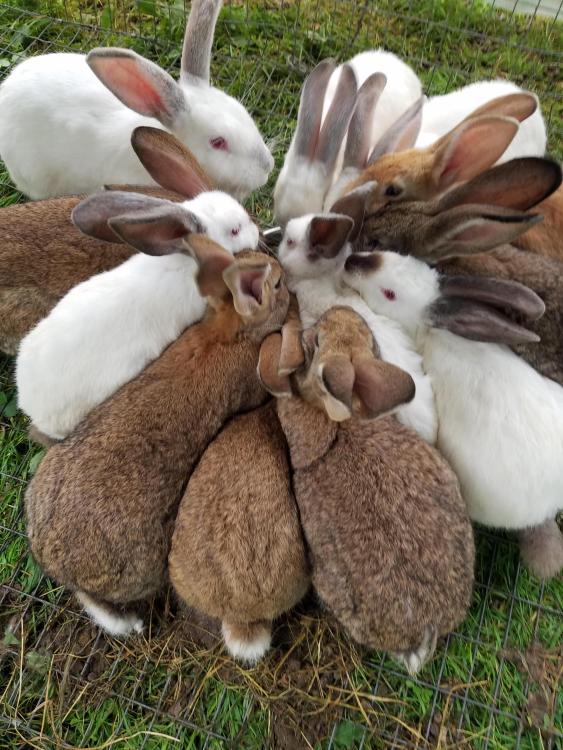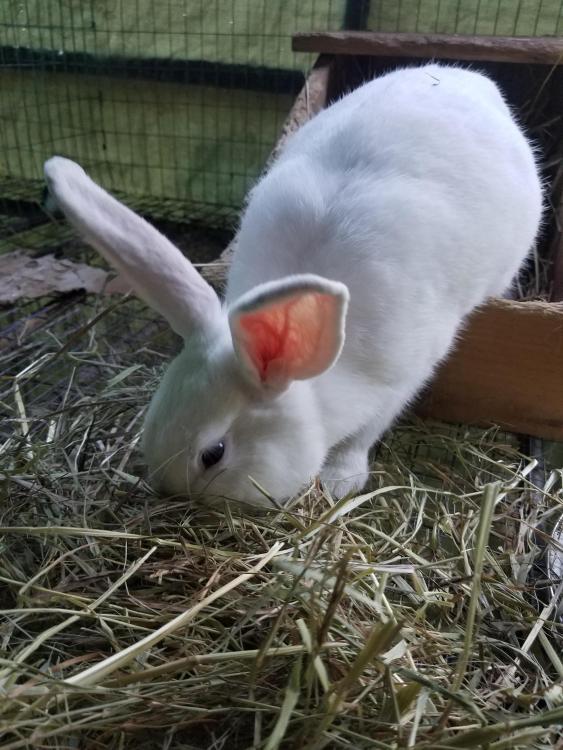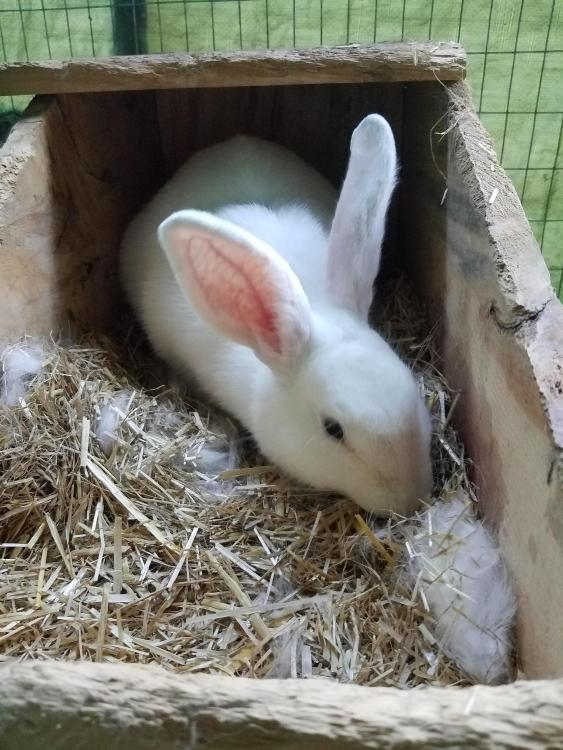It's been a while since my last update, partly because of busy-ness and partly because there was relatively little to relate. I have a bit of time this morning, though, and have some random things to share, so this will be something of a sprawling, meandering post.
One thing I was surprised to learn when we first started with rabbits was that they're really, really deft at handling objects with their mouths. A couple of our does have the amusing habit of stacking their food and water dishes once they're emptied, and if I'm late bringing up the rations a few of 'em will start banging their dishes against their cages or shelters when they hear me coming (in the approved tin-mug prison movie style). The funniest example of this came about a month ago.
I've mentioned in previous posts a couple of our younger bucks, black-furred Pepper II and blue-eyed Frank. In the course of things, as our bunny population ebbed and flowed, we found ourselves short on cages and were forced to put the two young bucks together for a while (if they were older they'd fight, but juveniles generally get along okay for a time). I mentally thought of this cage as the "bachelor quarters." One day, as I came up to feed the rabbits, I watched in surprise and delight as the two bachelors took turns tossing and flipping their dishes one after the other, for all the world like a couple of bored teenagers playing "football" with a coin or tossing bottle caps. They'd retrieve their dish, bring it back to the back of the cage, and then toss again. I have no idea whether they were competing on distance or style, but it was impressive.
...and speaking of those "bachelor quarters," something happened a few mornings ago that made me raise my eyebrows. I came into the lean-to as usual for the morning feeding, topped up the water and pellets, and gave them a big bundle of hay. Frank immediately pounced on the hay, but instead of chowing down on it he began gathering it up in big mouthfuls.
Now this is not at all unusual behavior, I've seen it many times in the past year. In does. Who are about to give birth, and feeling the nesting urge. Ummm.
So I separated them and placed Frank (or "Frannie," as I'm now calling her) into the adjoining cage, with a nest box full of straw, which she wasted no time arranging to her satisfaction. You can't leave the buck and doe together in a cage at birthing time, because the buck will kill the newborn kits and/or toss them out of the cage (this happens in many species; the male knows he's not getting any until the youngsters are weaned and therefore Takes The Necessary Steps). Unfortunately this cage has had an unsatisfactory roof all along, because we'd run out of the proper wire and used range fencing over top (4-inch squares, meant for larger livestock) with various patches meant to keep the rabbits in place. You can see where this is going, right? Yup... next morning I went up early to feed the bunnies and see if Frannie'd had a litter, and she was back in Pepper's cage and there were 10 kits on the ground.
Two of them were dead but the other eight were still warm and lively, so I put them back in the nest box and returned Frannie to her duties (she wasn't happy, as the scratches on my forearm can attest). I found more and better materials to patch the roof temporarily, and fixed it properly with a sheet of chicken wire that afternoon, so it won't happen again in future. The eight survivors are all lively and vigorous, so clearly Frannie has settled into the mothering role (a lot of does don't do well with their first litter, so this wasn't necessarily a given).
I'd been meaning to get a pic of "Frank" so you could see those beautiful blue eyes, but it hasn't been easy. These are the best I've managed so far, while she was arranging the nest box to her satisfaction:
As a followup to our previous discussion of coat colour and genetics, I'll note that all of the kits are black like their father.
We're considering how large an establishment of rabbits we'll want to carry forward to next year, because currently we're raising more than we need. My stepdaughter and the grandkids are not at all keen on eating rabbit, so I'm only feeding two of us rather than six. Also, we've found that having them out on grass over the summer hasn't meant as much of a saving on feed as we'd anticipated; the impact has essentially been negligible. In witness whereof, here's what happens when they get their pellets:

We like the idea of having them on grass - emotionally it's satisfying - but in practice it's been a real complication with few benefits and some notable downsides (the mysterious deaths I'd mentioned earlier weren't happening inside). We may opt next year to limit ourselves to just the number we can reasonably keep up at the barn. I've been brainstorming ways to make the tarped sides of their enclosure roll up and down, to give them more light and fresh air when the weather permits. We'll see how it all shakes out.
Presently we have 30-odd rabbits in the freezer and 40-odd kits in various stages of growth. That's going to be plenty for our purposes, and a few left over for barter and for gifting family and friends.
On that note, and in the spirit of back-filling useful information for planning purposes, when we harvested our last batch of 14 (the ones you see clustered around the bowl in the above pic*, plus a few from another cage) I kept track of the time required. From start to finish - wrangling them from their cage one at a time, doing the deed, skinning, gutting and cleaning, prepping for the freezer, and then salting down the pelts - took 6 hours, though that includes time spent feeding the other rabbits and stuffing a few pieces of (delivery) pizza into my own face. It works out to about 20 minutes/rabbit, which seems reasonably efficient. At our first harvest we processed only 6 rabbits and it took me the same length of time, though in my defense it was the first time I'd skinned and gutted a bunny in 50 years or so.
That's useful information to have for planning purposes, and I'm rather sheepish that it took me this long to quantify it. It'll be a big help though the fall, because now I'll know how much time to block off (and how early to start!) for any given batch.
On another practical note I've been putting the rabbits into regular freezer bags (the twist-tie kind) initially, but will allocate time to transfer the now-frozen bunnies into vacuum-seal bags for longer-term storage. Freezing them first in the other bags means I don't have to worry about blotting them scrupulously dry before putting them into my FoodSaver (and no, before anyone says it, a chamber vac just isn't in my budget for the year). ![]()
I'm not sure how much more I'll have to say about the bunnies going forward, but I may occasionally post a pic or two just because - let's face it - rabbits are cute.
*The runty white one with the dark ears that you see in roughly the 5:00 position got a reprieve, and is now sharing the grow-out cage with a younger litter who are roughly the same size.
ETA: I should clarify on the Frank/Frannie thing that a) it's really hard to sex rabbits accurately when they're small; and that b) "he" was a throw-in when we picked up our grey breeders. That was a cash-and-trade deal that saw our white doe Salt go home with the other woman, but she brought along the blue-eyed (ahem) buck on spec to see if we'd want him because of those blue eyes. And we did, and we did take a quick look, but... see a). The grey ones got a much closer scrutiny, but "Frank" was younger and smaller, and well, these things happen.



